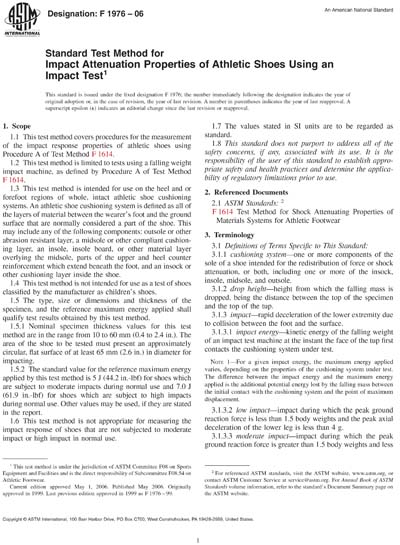Historical
ASTM F1976-06
Standard Test Method for Impact Attenuation Properties of Athletic Shoes Using an Impact Test
1.1 This test method covers procedures for the measurement of the impact response properties of athletic shoes using Procedure A of Test Method F 1614.
1.2 This test method is limited to tests using a falling weight impact machine, as defined by Procedure A of Test Method F 1614.
1.3 This test method is intended for use on the heel and or forefoot regions of whole, intact athletic shoe cushioning systems. An athletic shoe cushioning system is defined as all of the layers of material between the wearer's foot and the ground surface that are normally considered a part of the shoe. This may include any of the following components: outsole or other abrasion resistant layer, a midsole or other compliant cushioning layer, an insole, insole board, or other material layer overlying the midsole, parts of the upper and heel counter reinforcement which extend beneath the foot, and an insock or other cushioning layer inside the shoe.
1.4 This test method is not intended for use as a test of shoes classified by the manufacturer as children's shoes.
1.5 The type, size or dimensions and thickness of the specimen, and the reference maximum energy applied shall qualify test results obtained by this test method.
1.5.1 Nominal specimen thickness values for this test method are in the range from 10 to 60 mm (0.4 to 2.4 in.). The area of the shoe to be tested must present an approximately circular, flat surface of at least 65 mm (2.6 in.) in diameter for impacting.
1.5.2 The standard value for the reference maximum energy applied by this test method is 5 J (44.2 in.-lbf) for shoes which are subject to moderate impacts during normal use and 7.0 J (61.9 in.-lbf) for shoes which are subject to high impacts during normal use. Other values may be used, if they are stated in the report.
1.6 This test method is not appropriate for measuring the impact response of shoes that are not subjected to moderate impact or high impact in normal use.
1.7 The values stated in SI units are to be regarded as standard.
This standard does not purport to address all of the safety concerns, if any, associated with its use. It is the responsibility of the user of this standard to establish appropriate safety and health practices and determine the applicability of regulatory limitations prior to use.
Content Provider
ASTM International [astm]






